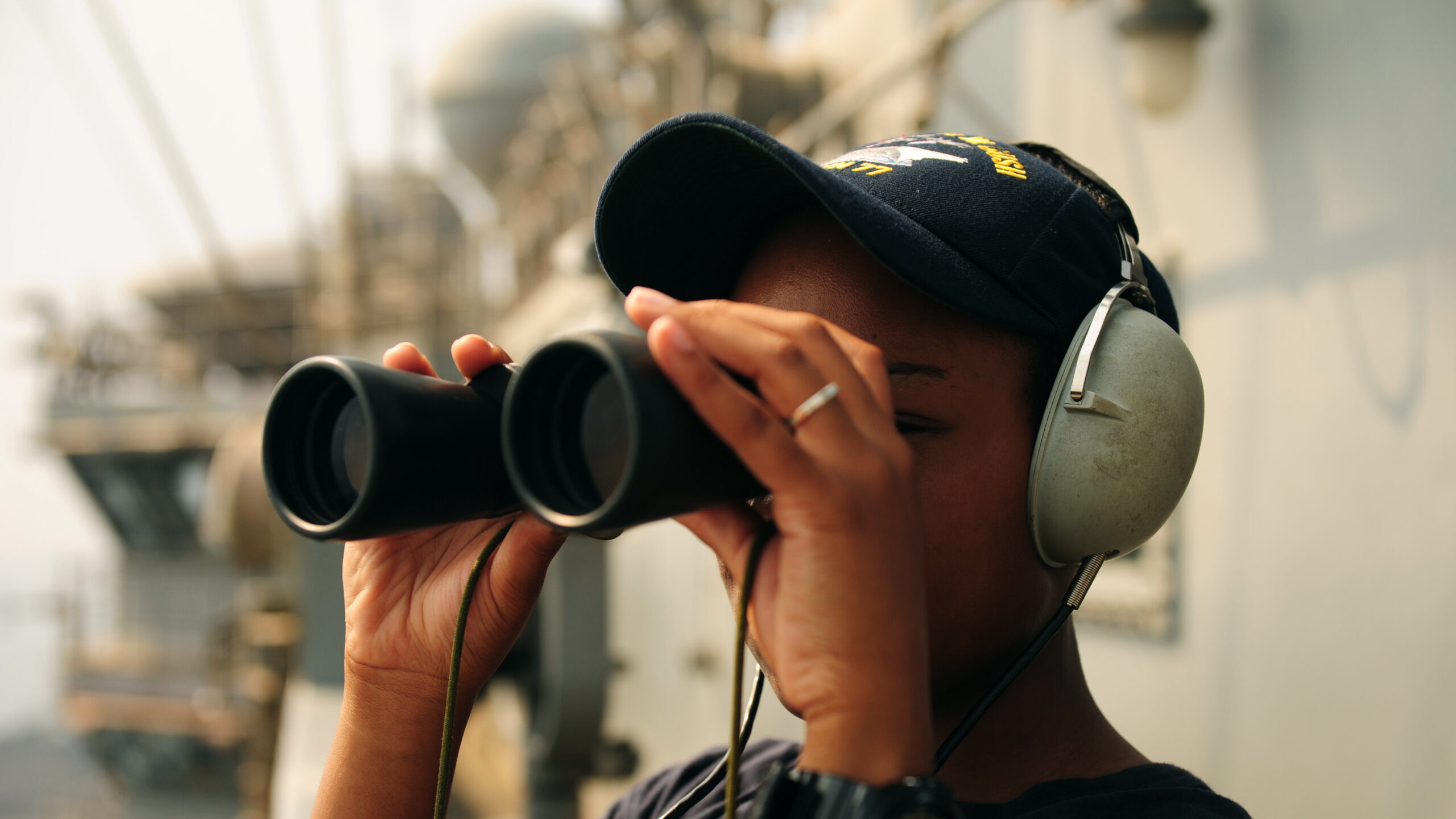AGNES HELOU

U.S. Navy Seaman Justice Bryan stands watch aboard the aircraft carrier USS George H.W. Bush (CVN 77) in the Persian Gulf Aug. 28, 2014. (U.S. Navy photo by Mass Communication Specialist 3rd Class Brian Stephens/Released)
BEIRUT — Iran‘s recent seizure of two merchant vessels from international waters has thrown the spotlight, once again, on the aggressive nature of how Tehran operates around its territory. But with the US shifting its attention from the Gulf region and towards Russia and China, it’s uncertain if there are enough assets to make sure Iran’s movements are tracked regularly.
That’s the question raised by a new report from the International Institute for Strategic Studies (IISS), a London-based think tank. In late April, the group issued a report called “Watching Iran: the ISR Gulf” addressing whether cooperation among the Gulf countries, combined with ISR capabilities with the US fifth fleet in the region, can accomplish regional security goals in Hurmuz Strait, the Gulf of Oman and Arabian Gulf.
“Intelligence, Surveillance and Reconnaissance coverage of Iran is and will continue to be a central element of bolstering regional security,” the report warns, adding that “Gulf countries, while holding some ISR capacity at the national level, currently lack the overall resources to fully replace those elements that Washington is redeploying [elsewhere], as do their allies.
“Furthermore, the Gulf Cooperation Council (GCC) states continue to struggle in moving beyond national approaches to the challenge of Iran, not only in terms of ISR but also, for instance, ballistic-missile defense, despite Washington’s best efforts to encourage a more collaborative approach.”
The report scanned Iran’s defense capabilities, both from regular army and the Revolutionary Guard, and despite showing that many of the systems operational by the air force, navy and land forces are obsolete, found Iran has been maintaining them and adding new capabilities — mainly unmanned systems and missile defense systems — to its inventory.
Comparing the technology between the systems operated by the Gulf countries and the outdated systems operated by Iran, gives the former an obvious advantage, but this is not really the point, Douglas Barrie, co-author of the report told Breaking Defense in a May 8 interview.
“Being capable of developing systems that meet the requirements is what matters. Using inexpensive systems to destroy advanced expensive systems is the case here,” he said.
Also holding back the Gulf states, the report noted, is that they operate at a national, not regional, level. Going collective could be the key to unlocking the potential of getting eyes everywhere in the region.
However, there are opportunities to be found. that although the gap left by US moving defense systems to Ukraine and the Indo-Pacific region is certainly considerable, it can be closed through cooperation, training the back-end operators and ISR coverage.
“The US tried to encourage cooperation across the ISR Task Force task, to come up with overarching agreements amongst all the players which can solve the missile defense in the Gulf issues,” Barrie said.
Navy Plans For ‘Digital Ocean’
Cmdr. Tim Hawkins, spokesman for US Naval Forces Central Command, US 5th Fleet and Combined Maritime Forces, said the US is focused on creating joint operational capabilities.
“One of the areas we see tremendous opportunity for strengthening regional maritime security is in building towards a common operating picture. The integration of unmanned and artificial intelligence platforms that provide persistent ISR is fundamental to this goal,” he told Breaking Defense.
He added that NAVCENT is working side-by-side with regional partners to build a fleet of 100 surface drones by end of the summer.
“Having more eyes out on the water through these drones, most of which will be operated and employed by regional nations, will enhance our collective ISR capability at sea,” Hawkins said.
NAVCENT through both Task Forces TF59 and TF99 has been operating in the Gulf waters a number of USVs including Saildrone Explorers, MARTAC T-38 Devil Ray, L3 Harris Arabian Fox MAST-13, Ocean Aero Triton and others.
Hawkins noted the cost of unmanned systems makes the value proposition easier for other partners in the region to join in, creating what Fifth Fleet is billing as a “digital ocean” concept.
“This means having every partner and every sensor collect new data that gets added to an intelligent synthesis of around-the-clock inputs encompassing thousands of images from seabed to space, from ships, unmanned systems, sub-sea sensors, satellites, buoys and other persistent technologies,” he said.
Hawkins told Breaking Defense that in 20 months, surface drones were sailed on every side of the Arabian Peninsula; surpassing 40,000 operating hours for unmanned surface vessels, which is the equivalent of 19 years of nine-to-five operations at sea five days a week; and conducted more than 20 unmanned naval exercises.
“The rapid progress we are making will enable us to realize the digital ocean vision soon,” Hawkins highlighted.
When asked about the next step to maintain security in the region Cmdr. Hawkins answered, “Let’s be clear on this, it is Iran’s responsibility to cease its unwarranted, irresponsible and destabilizing behavior in regional waters. Iran’s pattern of harassing, seizing and attacking internationally flagged merchant vessels needs to stop. U.S. 5th Fleet will remain vigilant while coordinating closely with the shipping industry to offer assistance when needed, and collaborate with regional allies and partners to enhance our collective ability to monitor what’s happening at sea.”
He added that having greater visibility will help 5th Fleet position and employ resources more precisely. “We are fully committed to protecting the rights of regional mariners to lawfully navigate waters across the Middle East safely,” Hawkins concluded.
No comments:
Post a Comment